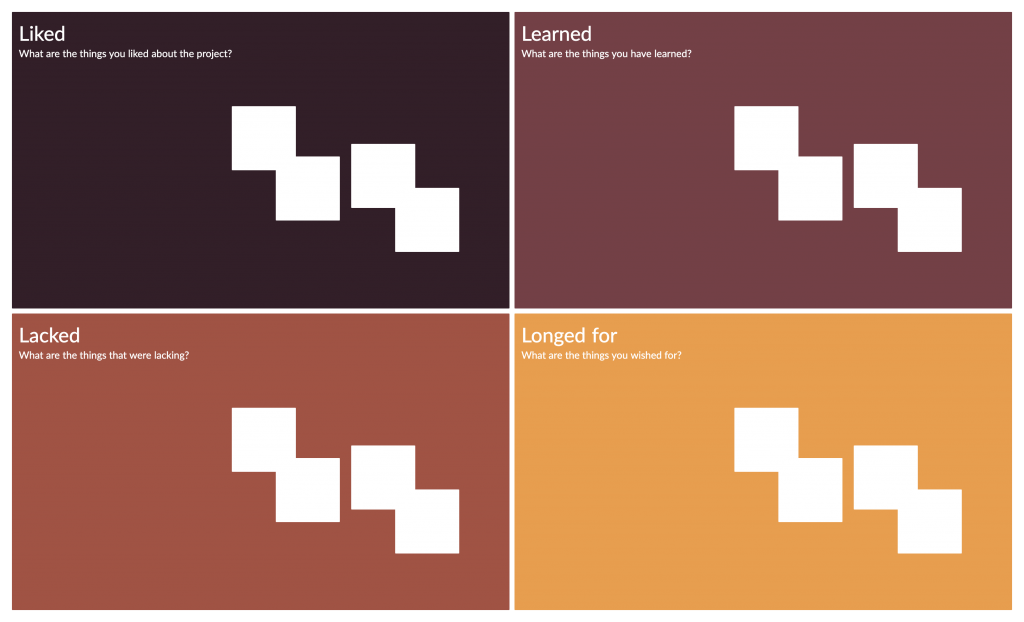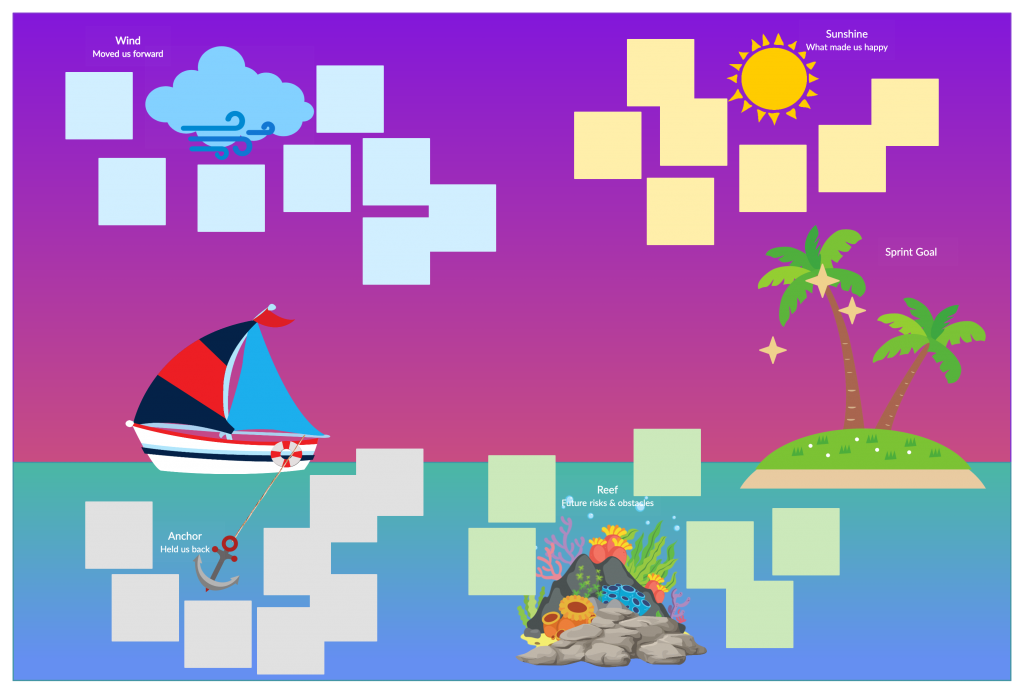Retrospective meetings are even more important to remote teams than they are to co-located ones.
Because remote teams don’t get to work next to each other on a daily basis, they often miss out on opportunities to detect the complications in their workflow that can affect their performance and spirit early on, which may eventually delay the timely completion of their project deliverables.
Regular retrospectives can help remote teams avoid this by providing the platform for every team member to speak their mind, talk openly about the challenges or blockers hindering their work, hence completing everything efficiently.
This post will walk you through all elements of a retrospective meeting, with a special focus on running them effectively, remotely. All templates provided are editable online, and you can use them to start your retrospective meeting right away.
What is a Retrospective Meeting
Known by many names – Scrum retrospective, sprint retrospective, agile retrospective, after-action review, and even sometimes post-mortem or wrap-up – this type of meeting is a timeboxed event where teams come together to discuss and reflect on what went well and what went wrong during their last Sprint or iteration. This enables them to improve their next Sprint by learning from their past mistakes and triumphs.
Although originally was generally used in agile software development, retrospective meetings have been adopted by many other teams in marketing to HR management over time.
The basic steps
- Go over the work that was planned, completed, or unfinished and other significant events that may have occurred during the Sprint/ project. You can use a retrospective template like the one below and encourage the participants to fill it out. This will help you keep track of the conversation and the important ideas shared easily.

- Go over each of the items put on the board by the participants and discuss them in detail.
- Decide how to improve future projects based on what you’ve learned during the retro and create action items for implementing those improvements during the next iteration. Assign an owner to each of these actions. During the next retro, you can check back with the owner to see if it has been implemented; if not it will continue on to the next iteration.
Who should participate
Invite only the immediate team members who work together. Retros provide a safe space for the participants to talk about everything out in the open, including the challenges they are facing, what they are failing at, and the help they need. Therefore you can avoid inviting someone (say a manager or stakeholder who isn’t directly involved in the work the team does) who might make them feel vulnerable or uncomfortable to speak openly.
What you need
In order to keep things organized and focused, you need to write things down, especially what’s being communicated by the team during the meeting. To do that, you need a whiteboard.
During a remote retrospective meeting session, you need to however switch to an online whiteboard where you and your team can collaborate (perhaps even better than you would have around a physical whiteboard) on sharing your ideas, questions and opinions.
- Creately is an online whiteboard/ online canvas tool designed for team collaboration. It comes with an infinite canvas, standard shape libraries for 50+ diagram types, in-app video conferencing, real-time change previews and mouse tracking, and in-line commenting. All of this combined, it makes a great tool for running retrospective meetings, brainstorming sessions, planning meetings, etc. online.
In addition, you may also need a video conferencing tool (only if the online whiteboard software you use doesn’t support in-app video conferencing) to facilitate the meeting online. Some options you can consider are,
Alternatively, you can also make use of a document collaboration tool like Google Docs or Google Sheets along with one of the video conferencing tools above to carry out the retrospective meeting.
Tips for Running Retrospective Meetings Remotely
Running an in-person retro meeting is quite different from running one online, mainly because the team is distributed across the continent, if not across the world, and is limited by their devices in terms of how they conduct themselves during the session.
However, it doesn’t mean that doing a productive retro remotely is impossible. Here are some tips to keep things effective and engaging online.
Make sure everyone participates
If your team is spread across different time zones, make sure that you choose a timeslot convenient for everyone. Usually, retros are held at the end of a Sprint (they could also be carried out during the Sprint/ project if it spans over a long period of time). As you plan your Sprint, remember to schedule the retros on to the team calendars early on. Timebox your session and try to finish it within the allotted time to avoid making any inconvenience to the participants who might be skipping lunch to join the meeting.
Make sure that everyone participates. If they are unable to, ensure that they at least provide their input prior to the meeting so they can still be referred to and discussed during the meeting with everyone else. You can use a pre-made retrospective template to gather their feedback.

Follow the general online meeting etiquette
Things sometimes tend to get out of hand during an online meeting, and setting guidelines help manage it all better. For a more productive outcome, have what you expect of your meeting attendees and how you want them to conduct themselves explained, prior to the meeting.
Some of the general meeting etiquette to follow as attendees are,
- Dress appropriately
- Make sure you are set up in front of a background that is work-appropriate (i.e. no beds, messy rooms, etc.)
- Mute your microphone when you are not speaking
- Don’t get distracted. Don’t stare at your phone, type away on your keyboard or work on other tasks when someone else is presenting
- Put your phone on silence and turn off other notifications
- Don’t interrupt while others are speaking or talk over them
- If you have a comment or a question, bring attention to yourself before speaking. Either make a hand gesture or say ‘question’ or ‘comment’
- Be ready. Make sure your connection, camera, and microphone are working before the meeting
How to Run a Productive Remote Meeting | Best Practices and Templates
Collect feedback prior to the meeting
In order to spend more of your actual retrospective meeting time analyzing the ideas given and discussing action items for the future, collect the team’s feedback prior to the actual session.
Share one of the retrospective templates below with the team ahead of time, allowing everyone to list down their failures and triumphs, and concerns, and suggestions. This approach can also help introverts feel more comfortable with sharing their ideas and encourage the members who may think their feedback is more critical to share it without feeling apprehensive.
Create an action plan
Distributed teams easily lose track of who is responsible for doing what and when things are due. In order to avoid any confusion and hold everyone accountable, create a simple action plan that is shared with everyone.

Or you can use a project management tool like Favro to create tasks, assign owners and track progress.
Use the correct retrospective technique
The standard retrospective has the team answering the questions, what went well? what didn’t go well? and what can we improve? While this is fairly straightforward, it might make things stale when you do it repeatedly. Here are a few retrospective meeting ideas to make things more fun and engaging.
This approach gathers participants feedback across 3 categories;
- What should the team Start working on?
- What should the team Stop working on?
- What should the team Continue to work on?

Liked, Learned, Lacked, Longed for (4 Ls)
Split the canvas into 4 areas and ask the participants to individually provide their ideas on each of the Ls.
- Liked – things they liked about the project
- Learned – things they have learned
- Lacked – things the team has done but could have been done better
- Longed for – things that they wished for during the project

This approach lets the team share and group their feedback based on their emotions about the previous sprint
- What they were mad about
- What they were sad about
- What they were glad about

Once the ideas are grouped, the team can vote for them. The ones with the most votes will be prioritized and will be taken action on during the next sprint.
Sailboat
This method technically compares the sprint to a sailboat, getting the team to compare the things that affected the sprint to what propel a sailboat forward or backward.
- Sunshine – things that made the team happy
- Anchors – things that held the team back from making progress
- Wind and clouds – the things that helped the team propel forward
- Rocks and pirates – risks and obstacles that may prevent the team from where they need to be

KALM
KALM stands for,
- Keep (things that you need to keep)
- Add (things you need to add)
- More (things that you need more of)
- Less (things that you need less of)

Find more retrospective techniques here.
Got More Tips for Running Productive Remote Retrospective Meetings?
At the end of the retrospective meeting, you can take a little time to reflect on how it went (a short retrospective on the retrospective!). Encourage the team to share their feedback on how to improve the retrospective to make it more productive the next time.
Retrospective meetings give you the opportunity to reflect on the mistakes you’ve made and where you thrived in order to plan for a better future. Although running a remote retrospective may have put you in a difficult position in the past, we hope this post and the templates we have shared will help you do it successfully from now on.
If you have something that has especially worked for you when running remote retrospective meetings, please share it with us in the comments section below.





